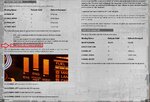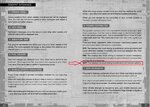Thanks. I was sure I hadn’t dreamed a cooling effect. So in practical terms a weapon mod like short range which increases thermal load, but not distributor draw, what happens when you fire it? I assume the ship heats up, but the distributor runs down at the same rate as an unengineered weapon. So if I can keep the ship cool with thermal vent, heat sinks or thermal efficient build it will still fire as long as the Wep distributor has some charge?
A number of years ago fdev did a revamp of heat mechanics. I won't go into what it used to be but part of the change made it so heat from weapon discharge (thermal load) increases dramatically if wep is empty. Otherwise, the "thermal load" is a fixed value applied to your ship every time it is used (or per second for beams I suppose).
The wep pool (capacity) of the pd is depleted with each shot that consumes energy (energy weapons draw from the distributor but kinetics consume ammo - though I think kinetics do draw a much reduced value but not certain about this without checking) and has a recharge rate that is reduced if you divert pips elsewhere (so fewer than 4 to wep). The capacity is initially set by the size and quality of the pd (then changed by engineering). There's zero relation between the size or quality of the power plant and the values of power used/imparted by the pd (and the pp only controls two functions, limiting the total capacity for value of power from fitted/deployed modules and the heat efficiency of your ship). There's no logical process that literally "takes" power from the power plant into the pd to both charge capacity and equally generate a realistic and proportionate value of heat when that power is used.
All active modules add heat in idle. Some add more when in use (ie charging fsd, thrusters when boosting Scbs when fired. Weapons add more when fired). I'm not actually certain if there's a visible stat that tells us idle and "actioned" thermal load. Someone might be able to confirm this for me.
External heat sources simply add to your ships base heat (fuel scooping, thermal shock). Your pp efficiency reduces the impact of base heat (idle) and I'm guessing higher efficiency will reduce heat faster back to idle state but that's just a guess.
So, firing a weapon will take power from the current wep capacity. It's a fixed value. It'll add a certain value of heat to your ship, again fixed value. Only when your wep cap is empty does your weapon generate additional heat.
There is no particular real science behind this. The wep capacitor isn't "cooling weapon systems" and pips have no direct impact over heat - although the handwavium could be that it requires
some wep power capacity to keep the basic cooling running. Either way, it's purely a game play mechanic designed to balance weapons and give you an interesting strategic choice in combat (a skill based function) with a consequence to allow the player to "overburn" at the expense of massive heat. It literally holds power for your weapons to use up and the rate it refills its capacity is dependent on the size, quality, engineering and pips applied. It isn't dependent on some cleverly calculated, real world physics that conduits actual power from your power plant and imparts it as power consumed and equal parts heat generated.
Systems pips can't work the same way because shields just don't work that way (we don't "fire" shields). It's just a pool of power that's depleted when shields recharge. As mentioned above, it has an additional benefit of adding hard coded resistance to damage ("power to shields"). It also has, I believe, a bonus to sensor strength (longer range sensors at 4 pips). There's a bit of strategy here when building a ship; if your sys cap total is too low, having fast charge bi weaves might recharge slower... Because this process eats up your sys capacity faster than it recharges even with 4 pips. In this case, low draw shields are better. Again, this just goes to demonstrate how the relationship isn't necessarily a lesson in the physics of electronics... It's just stats management.
Eng is pretty obvious, as outlined above. Purely a game play pool that draws power when boosting, otherwise has a hard coded multiplier to thruster power.
These "additional effects" (enhanced engine and shield performance because you use more pips or the penalty for exhausting wep capacity) really don't relate to anything. There's no answer to "where is the power from"? There's no relation between the PD, the power plant and the performance of your modules. It's all just pip management bonuses, pure and simple, and used to give reasons for us to adjust strategy mid fight.
When building a ship (and then engineering the PD), it's just a way to give the player more strategy choices. Balancing the capacity for shield regeneration (sys), speed (Eng) and how long you can consecutively maintain maximum dps output before needing to rest or risk heat damage (wep).
The pips just add a real time (skill based) element to that function with a couple bonuses to give us reasons for choosing something other than 4 pips to weapons.


